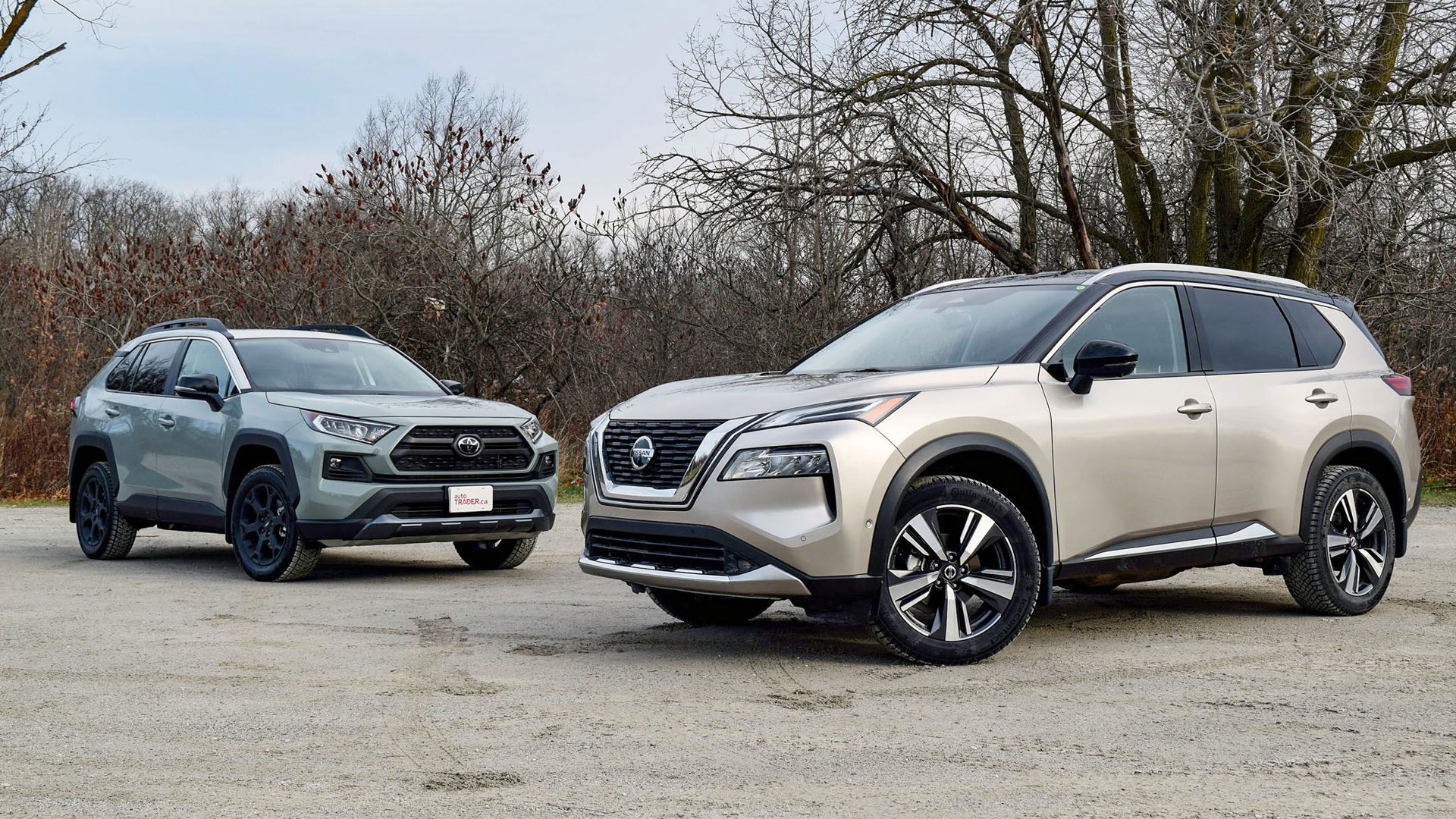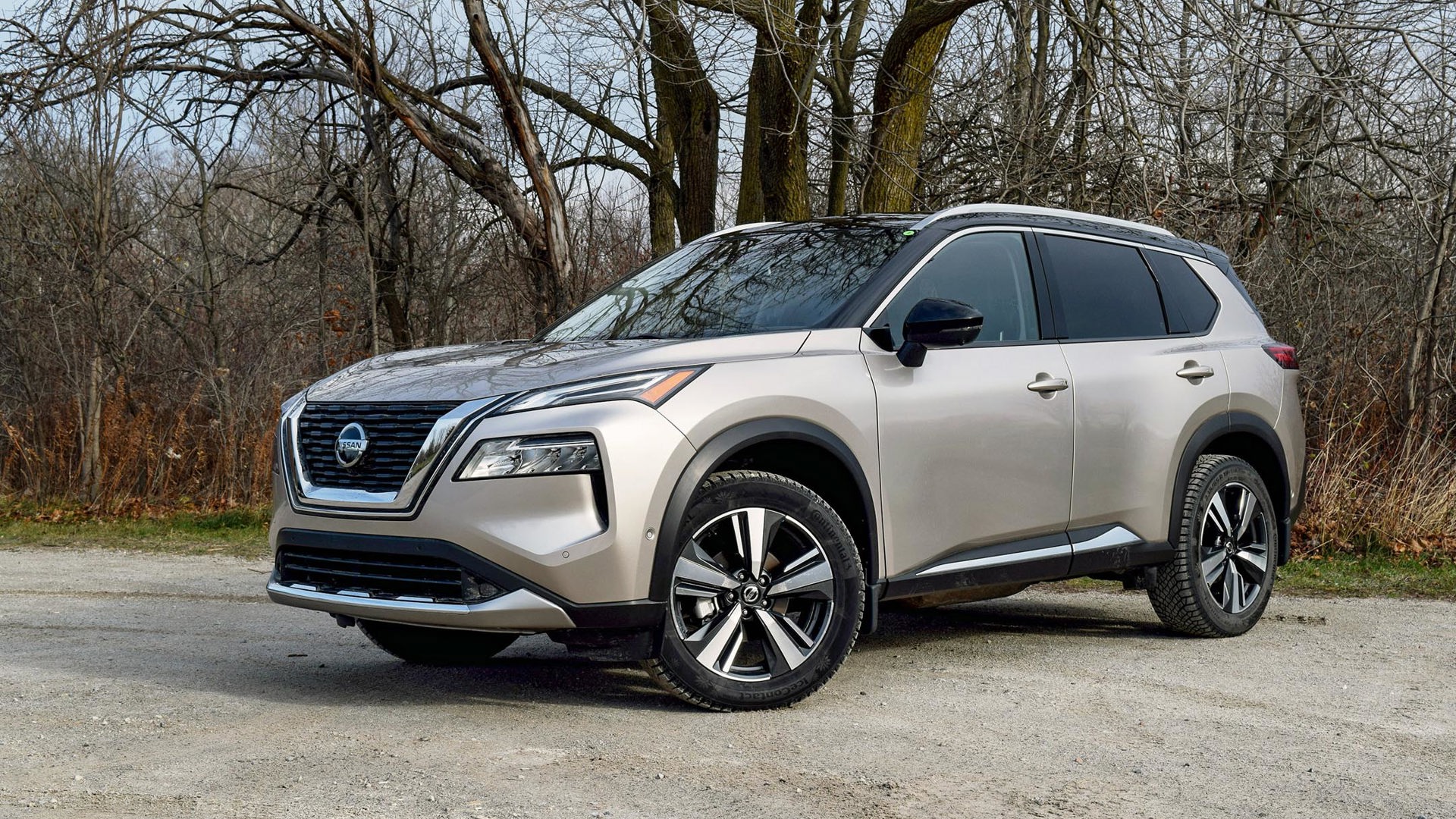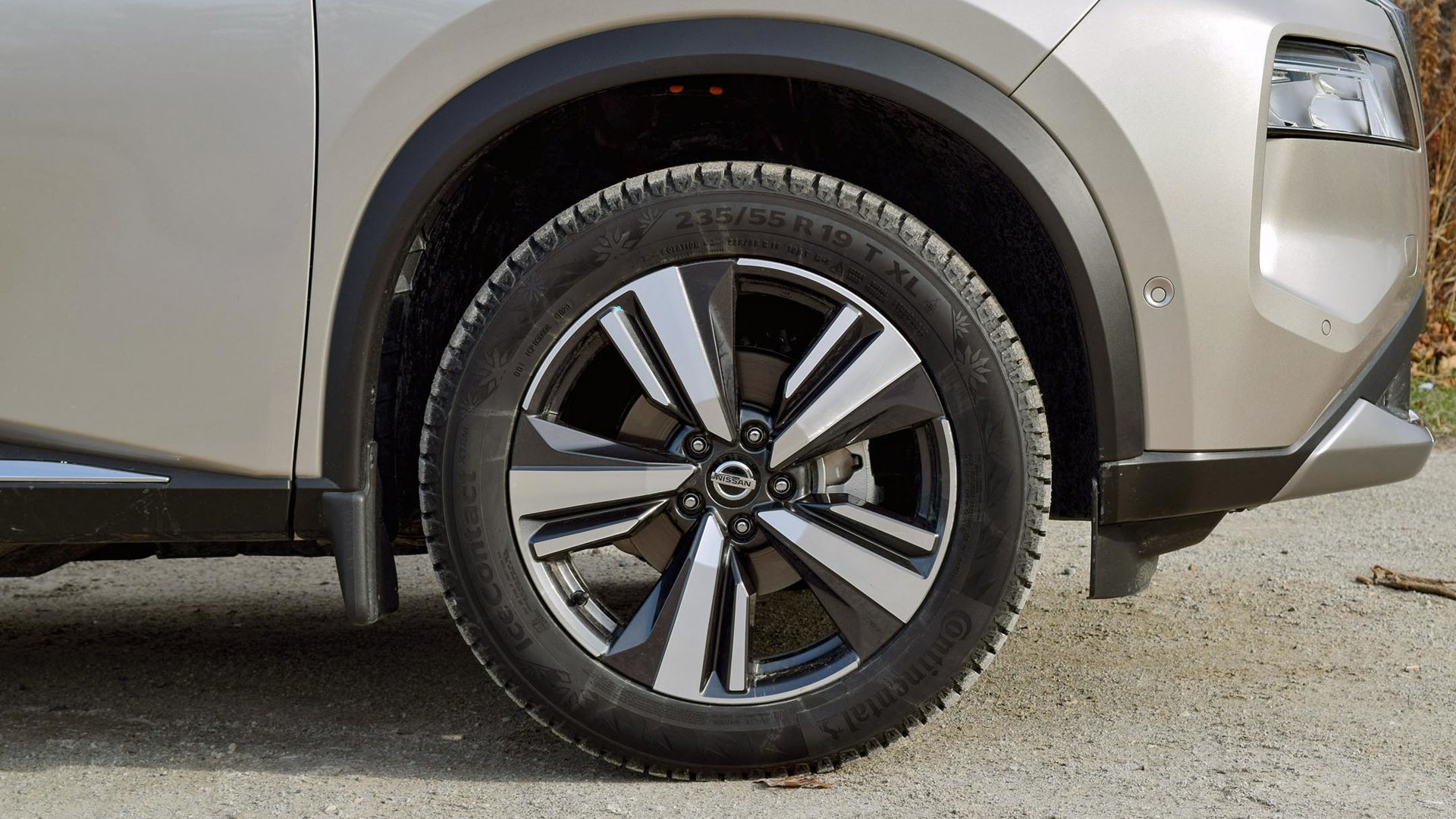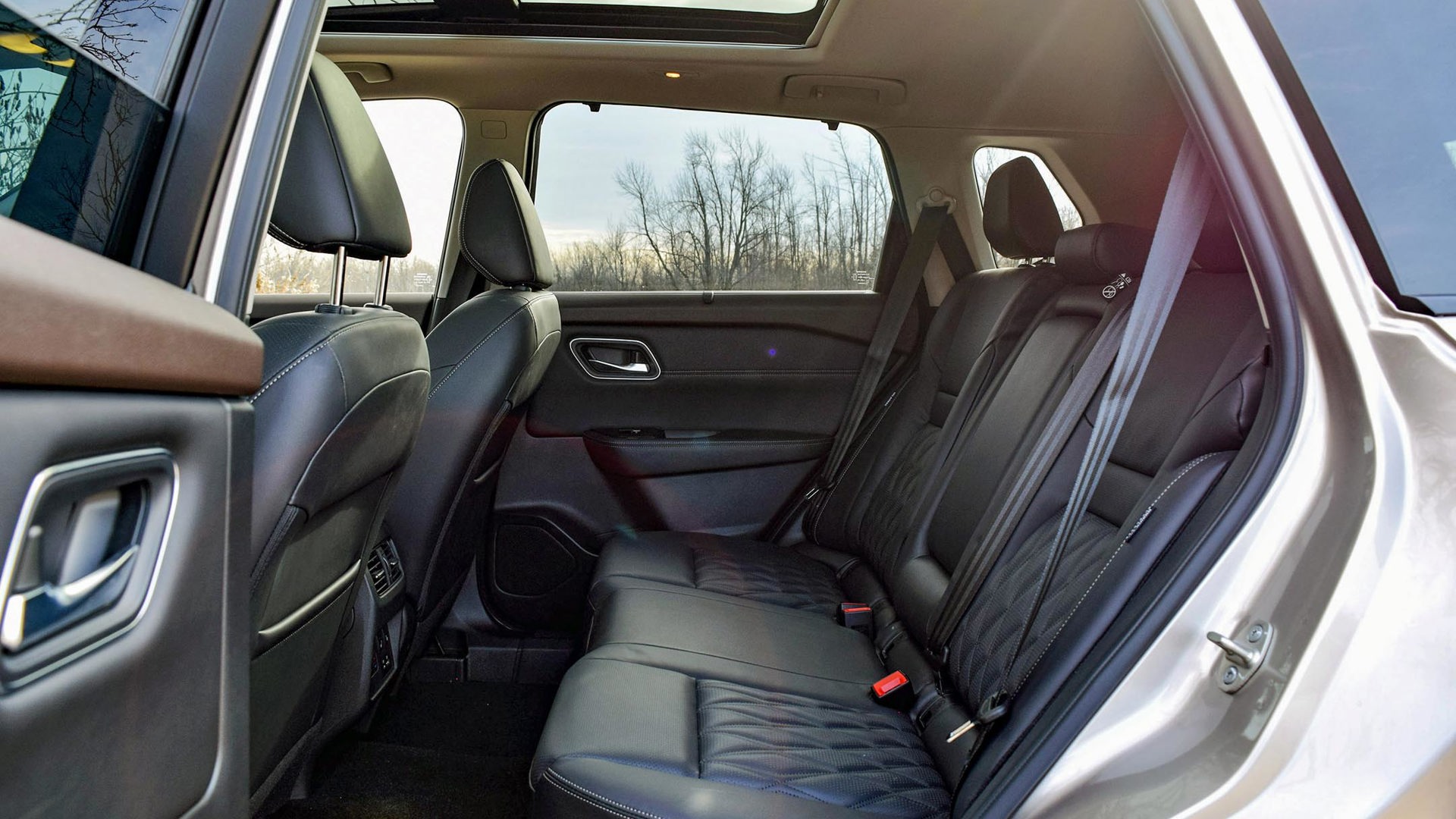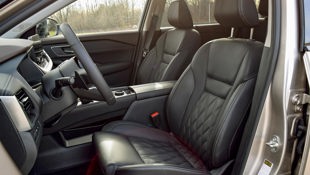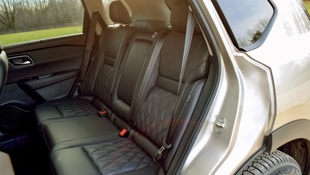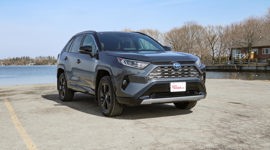Comparison Data
|
2021 Nissan Rogue Platinum
|
2021 Toyota RAV4 Trail
|
|---|---|
|
Engine Displacement
2.5L
|
2.5L
|
|
Engine Cylinders
I4
|
I4
|
|
Peak Horsepower
181 hp
|
203 hp
|
|
Peak Torque
181 lb-ft
|
184 lb-ft
|
|
Fuel Economy
9.2 / 7.2 / 8.3 L/100 km cty/hwy/cmb
|
9.4 / 7.1 / 8.4 L/100 km cty/hwy/cmb
|
|
Cargo Space
1,028 / 2,064 L seats down
|
1,059 / 1,977 L seats down
|
|
Base Price
$39,998
|
$39,050
|
|
A/C Tax
$100
|
$100
|
|
Destination Fee
$1,830
|
$1,840
|
|
Price as Tested
$41,928
|
$44,510
|
|
Optional Equipment
None
|
$3,520 – TRD Off-Road, $3,520
|
Compact crossovers are among the most popular vehicles on the market, though “compact” is something of a misleading term these days.
It only takes one look at the 2021 Toyota RAV4 to see the flaws in that characterization, the Canadian-built crossover coming across far larger than its segmentation would suggest – particularly with the optional TRD Off-Road package. Buyers have flocked to the RAV4 for years, and it’s built one heck of a reputation along the way. Capable, stylish, and easy to get acclimated to, it’s clear to see why this Toyota is so popular. However, Toyota’s lack of innovation has made it an easy target for critics and the competition.
That’s where the redesigned 2021 Nissan Rogue comes in. The automaker has thrown everything it’s got at the Rogue: high-tech features, improved advanced driving aids, and new styling inside and out. In short, it looks like a lock in this highly competitive segment.
Styling
Toyota nailed the exterior design of the RAV4, especially when outfitted with this TRD getup that’s only available on the Trail trim. Bringing to mind the rugged 4Runner, this is a far more inspired-looking RAV4 than the cute-ute styling of past generations. The two-tone roof signals a more playful persona from the usually prim-and-proper automaker, and as a whole the RAV4 is among the segment’s best from a styling perspective.
The interior carries a bit of that same bubbly charm, but it feels less effective. Where the exterior says bold and rugged, the interior has a bit of cheap and childish going on. The rubberized knobs and large controls by the gear selector are practical but remind me of a child’s toy or even a TV remote designed for the elderly. By contrast, the controls for the HVAC and infotainment systems are tiny, showing Toyota’s inconsistent interior design language. Fortunately, there are a few smart design applications, like cubbies with rubberized coatings to prevent items from sliding around. They may add to the childish demeanour, but at least they’re useful.
The Nissan Rogue’s exterior design isn’t easy on the eyes, which is a shame considering the appealing look of the brand’s other models. It’s as if Nissan wanted to mimic the high-class visual of its Maxima, but also wanted to throw in some elements of the Kicks or even the Leaf. It looks good in profile, but from other angles it appears a bit awkward, like a Lexus RX without the wild angles.
However, the influences of the higher-end Maxima and Murano shine throughout the interior of the cabin, especially in the top Platinum trim. Quilted leather seating wows passengers along with the two-tone themes offered. It’s all easy on the eyes but not necessarily to touch, as some items in the Rogue don’t feel as sturdy or well-fitting. Some of the knobs in the unit I tested had a bit of wriggle to them, and some materials felt a little cheap, like the plastics on the steering wheel. Otherwise, the Rogue has a fantastic interior design, going a bit further than Toyota does with the RAV4.
Toyota RAV4: 7.5/10; Nissan Rogue: 8/10
Safety
Both crossovers are loaded with safety equipment. Standard safety features in the RAV4 include blind-spot monitoring, lane-keep assistance, automatic high-beams, adaptive cruise control, and forward-collision warning with pedestrian and cyclist detection. Higher trim levels come with parking sensors, additional cameras, and rear cross-traffic alert. The Insurance Institute for Highway Safety (IIHS) is pretty keen on all of these features, rating the RAV4 as a Top Safety Pick; that’s the second-highest honour a vehicle can receive.
The IIHS has yet to test the new Rogue, but the last model was highly rated as well, so hopefully Nissan is able to keep that up here. Every 2021 Rogue comes with a forward-collision warning, blind-spot monitoring, rear parking sensors, high-beam assistance, rear cross-traffic alert, and lane-departure warning. The top two trims add the brand’s advanced adaptive cruise control and lane-keeping assistance, as well as side and front parking sensors, and a surround-view camera array. There’s even a speed-limit recognition system that can adjust the vehicle’s speed automatically.
In practice, I found the Rogue’s driver aids to be easy to use, with less erratic behaviour and beeping than most – including the RAV4. The way the adaptive cruise control responds to traffic is very natural, while the RAV4 can sometimes feel like it’s braking too late, or putting too much distance between itself and the vehicle ahead.
Toyota RAV4: 8/10; Nissan Rogue: 8.5/10
Features
In the past, compact cars and crossovers had a sparse selection of features, but that’s far from the case now. RAV4s equipped with all-wheel drive are offered with a handy terrain select mode, but non-drivetrain specific features offered by Toyota include a wireless phone charger, a kick-activated power tailgate, push-button start, heated steering wheel, ventilated front seats, heated front and rear seats, driver seat memory, dual-zone climate control, and a video display in the rear-view mirror. This display provides an unobstructed view of what’s going on behind the vehicle and can have a wider field of view as well. There’s also an available 11-speaker sound system.
The Rogue offers a similar array of features but puts a twist on some of them. For example, dual-zone climate control is standard, but three-zone is offered in the top trim. It also offers a wireless phone charger, but will also support wireless Apple CarPlay. The vehicle also features heated seats in the front and rear, a heated steering wheel, and rear window shades. As for audio, you can get a 10-speaker setup in the Rogue. There are a few other features that stand out in the Rogue as well, like the head-up display (HUD), digital gauge cluster, and Wi-Fi hotspot. It’s enough to give the Rogue the slight edge over the Toyota in this category.
Toyota RAV4: 7.5/10; Nissan Rogue: 8.5/10
User Friendliness
The Rogue is offered with a bigger touchscreen than the Toyota – nine-inch in the Nissan; eight-inch in the Toyota – while the digital gauge cluster and HUD provide a bit more information than the competition. There’s a limited amount of customization on the gauge cluster, which means some screens are overwhelmingly busy.
iPhone users should appreciate the wireless Apple CarPlay support, not to mention the wireless phone charger, but there’s even a USB-C port for quicker charging that allows for a hard connection to both CarPlay and Android Auto. The butterfly-style armrest cover also makes stashing and retrieving items from the console bin easier for both front-seat occupants, while Nissan offers a special divider for the cargo area for better organization. Finally, I appreciate the more reasonably sized physical controls in the Rogue, which are easier to read, reach, and understand than they are in the Toyota.
Without the same flashy screens, the RAV4 seems a bit dated and limited in terms of the information it provides the driver, but this can be a bit calming and simpler as well. The interfaces of the driver information display and infotainment system look downright awful, like an Atari in the age of Xboxes and PlayStations. The large knobs are nice and easy to use, but the smaller buttons not only look cramped but are mushy to feel and hard to read. The RAV4 Trail model with the TRD Off-Road package adds a rubberized cover on the back of the rear seats, which makes them easier to clean.
Toyota RAV4: 7.5/10; Nissan Rogue: 8/10
Practicality
Space-wise, these two vehicles are perfect foils for one another, one-upping the other in any given area. The Rogue features a bit more front headroom, while the RAV4 prioritizes the rear headroom. When it comes to legroom, the Rogue triumphs over the RAV4 in both the front and rear of the vehicle.
With the rear seats up, the RAV4 beats the Rogue in cargo space with 1,059 L of stowage compared to the Rogue’s 1,028 L. That story is flipped when the rear seats are folded as the Rogue features 2,064 L while the RAV4 has just 1,977 L, though in practice the RAV4 seems to offer more space. Determining which model is more practical depends on your priorities. The extra space in the rear of the RAV4 with the seats up makes it ideal for young families, while the extra rear legroom in the Rogue means it’ll suit families with taller kids or more passengers.
Toyota RAV4: 7.5/10; Nissan Rogue: 7.5/10
Comfort
The plush quilted leather seats in the Rogue help it feel more comfortable than the RAV4. The large sunroof adds to the spacious and airy feel, but the Rogue loses points for having a harsher ride than the RAV4. Thanks to the TRD Off-Road package, the RAV4 Trail I tested featured a different suspension system than the rest of the RAV4 lineup, which also makes it a bit less jarring on the pavement. Unfortunately, this leads to extra body roll and lean when cornering, which is better managed in the Rogue. One more aspect worth mentioning is noise levels in the cabin, where the RAV4 has more wind and tire noise.
Toyota RAV4: 7/10; Nissan Rogue: 7.5/10
Power
Under the hood of the RAV4 is a 2.5L four-cylinder engine that makes 203 hp and 184 lb-ft of torque, and is paired to an eight-speed automatic transmission. While front-wheel drive is found on a few models, my tester featured all-wheel drive. There are other variants of RAV4 out there, including two different hybrids, one of which is a powerful go-getter with about 70 km of electric range. I’d urge RAV4 buyers to go for one of the hybrid models over the gas-powered versions, as the combustion engine is loud and buzzy. The eight-speed automatic transmission is adequate, swapping gears when needed, and never a moment sooner.
The engine in the Rogue isn’t more powerful than what’s found in the RAV4, despite the fact that it’s also sporting 2.5L of displacement. In the Nissan, it makes 181 hp and 181 lb-ft of torque, but the continuously variable transmission (CVT) helps it feel much more responsive, though it can get noisy at higher speeds and when you call for acceleration. While I prefer the powertrain in the Rogue for general motoring, it’s a shame that Nissan isn’t offering an optional upgrade or alternate engine.
Toyota RAV4: 7/10; Nissan Rogue: 7.5/10
Driving Feel
The rugged-looking RAV4 plays the same part on the road thanks to its softer suspension. It rides nicely over broken pavement, but, as mentioned earlier, rolls a bit when it comes to turns and aggressive inputs. Furthermore, the squishy ride delays the throttle and steering responsiveness.
On the other hand, the Rogue feels a bit more agile and responsive. The light steering adds to the agile feel but reduces engagement. While stiffer than the RAV4, the Rogue feels planted and less prone to disruption on rough roads. It’s more refined than the Toyota but is far from the segment leader.
Toyota RAV4: 7/10; Nissan Rogue: 7.5/10
Fuel Economy
The gas-powered Toyota RAV4 has slightly different fuel ratings depending upon trim. The most fuel-efficient front-wheel-drive XLE model is expected to return 8.5 L/100 km in the city, 6.8 on the highway, and 7.7 in combined conditions, while the least thrifty all-wheel drive Trail or Limited models are rated for 9.4 L/100 km in the city, 7.1 on the highway, and 8.4 combined. For less fuel usage, consider the hybrid models.
The most fuel-friendly Nissan Rogue is the base front-wheel drive model, which is rated by Natural Resources Canada (NRCan) to return 8.9 L/100 km in the city, 7.0 on the highway, and 8.1 in combined conditions. All-wheel-drive models are good for 9.2 L/100 km in the city, 7.2 on the highway, and 8.3 combined.
Toyota RAV4: 7/10; Nissan Rogue: 7.5/10
Value
Toyota has a ton of trims to choose from, starting at $28,250 for the front-wheel drive LE, and $30,350 for the same version with all-wheel traction. The next choice is the XLE model, which runs for $31,850 or $33,950, depending on drive configuration. The XLE with all-wheel drive can also be equipped with a $2,800 Premium package that adds leather seating, an upgraded infotainment system, and larger wheels.
The Trail model, meanwhile, comes with all-wheel drive and a bunch of other goodies, and starts at $39,050. But it can be equipped with the flashy and functional TRD Off-Road package for an extra $3,520. Finally, the fully loaded Limited costs $41,350. These prices don’t include the $1,840 destination fee, which all adds up to make the RAV4 among the pricier vehicles in the segment.
The Rogue isn’t far off the starting price but has more standard features. It starts at $28,498 for front-drive S model, while the all-wheel drive version is an extra $2,300. The SV model is also front-wheel drive and costs $31,998, while the all-wheel drive version sells for $34,298 and can be equipped with a $2,200 Premium package, which adds appreciated features like heated rear seats, rear sunshades, a power tailgate, and faux leather seating.
Those with a higher budget will find the $39,998 Platinum model a slightly better deal than the fully loaded RAV4 Limited. Nissan charges a similar $1,830 destination fee.
Toyota RAV4: 7/10; Nissan Rogue: 7.5/10
The Verdict
Considering how limiting the RAV4 can feel at times, this showdown turned out to be closer than expected. While the Toyota feels just average in a few categories, like features and pricing, it’s competitive in areas like passenger room and driving style. Where it falls apart is the powertrain, but it has an eye-catching and rugged exterior design to make up for it.
The RAV4 continues to be popular with buyers, but the Rogue is worthy of attention thanks to its refined driving style, improved interior, and high-tech features. It also doesn’t hurt that Nissan shaves a few dollars off its compact crossover compared to top rivals like the RAV4. If you’re shopping these two, we’d lean towards the Rogue, but be sure to check out the rest of this incredibly deep and competitive segment.

